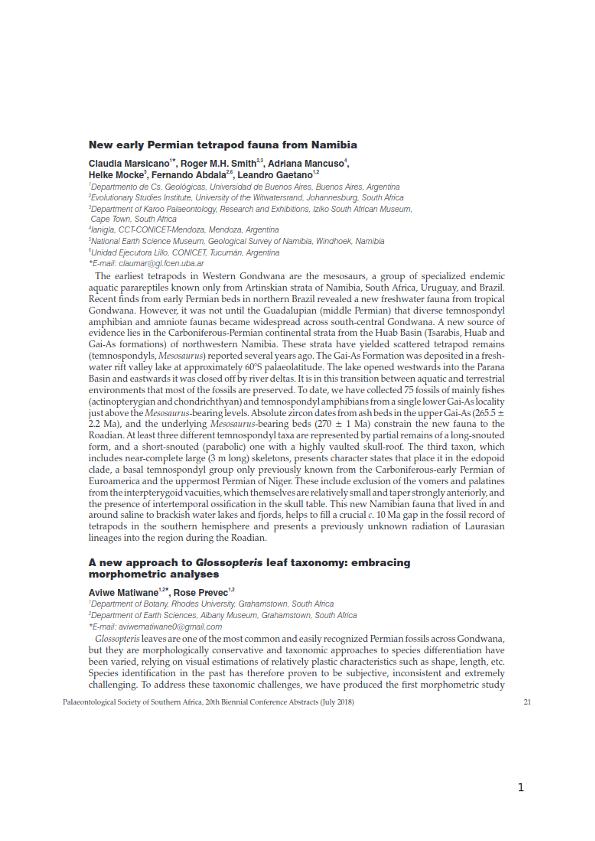Mostrar el registro sencillo del ítem
dc.contributor.author
Marsicano, Claudia Alicia

dc.contributor.author
Smith, Roger
dc.contributor.author
Mancuso, Adriana Cecilia

dc.contributor.author
Mocke, Helke
dc.contributor.author
Abdala, Fernando
dc.contributor.author
Gaetano, Leandro Carlos

dc.date.available
2024-02-16T14:37:01Z
dc.date.issued
2018
dc.identifier.citation
New early permian tetrapod fauna from Namibia; 20th Biennial Conference of the Palaeontological Society of Southern Africa; Sudáfrica; 2018; 1-1
dc.identifier.uri
http://hdl.handle.net/11336/227230
dc.description.abstract
The earliest tetrapods in Western Gondwana are the mesosaurs, a group of specializedendemic aquatic parareptiles known only from Artinskian strata of Namibia, South Africa,Uruguay, and Brazil. Recent finds from early Permian beds in northern Brazil revealed a newfreshwater fauna from tropical Gondwana. However, it was not until the Guadalupian (middlePermian) that diverse temnospondyl amphibian and amniote faunas became widespreadacross south-central Gondwana. A new source of evidence lies in the Carboniferous-Permiancontinental strata from the Huab Basin (Tsarabis, Huab and Gai-As formations) ofnorthwestern Namibia. These strata have yielded scattered tetrapod remains (temnospondyls,Mesosaurus) reported several years ago. The Gai-As Formation was deposited in a freshwaterrift valley lake at approximately 60°S palaeolatitude. The lake opened westwards into theParana Basin and eastwards it was closed off by river deltas. It is in this transition betweenaquatic and terrestrial environments that most of the fossils are preserved. To date, we havecollected 75 fossils of mainly fishes (actinopterygian and chondrichthyan) and temnospondylamphibians from a single lower Gai-As locality just above the Mesosaurus-bearing levels.Absolute zircon dates from ash beds in the upper Gai-As (265.5±2.2 Ma), and the underlyingMesosaurus-bearing beds (270±1 Ma) constrain the new fauna to the Roadian. At least threedifferent temnospondyl taxa are represented by partial remains of a long-snouted form, and ashort-snouted (parabolic) one with a highly vaulted skull-roof. The third taxon, whichincludes near-complete large (3 m-long) skeletons, presents character states that place it inthe edopoid clade, a basal temnospondyl group only previously known from theCarboniferous-early Permian of Euroamerica and the uppermost Permian of Niger. Theseinclude exclusion of the vomers and palatines from the interpterygoid vacuities, whichthemselves are relatively small and taper strongly anteriorly, and the presence ofintertemporal ossification in the skull table. This new Namibian fauna that lived in andaround saline to brackish water lakes and fjords, helps to fill a crucial ca. 10 Ma gap in thefossil record of tetrapods in the Southern Hemisphere and presents a previously unknownradiation of Laurasian lineages into the region during the Rodian.
dc.format
application/pdf
dc.language.iso
eng
dc.publisher
University Witwatersrand
dc.rights
info:eu-repo/semantics/openAccess
dc.rights.uri
https://creativecommons.org/licenses/by-nc-sa/2.5/ar/
dc.subject
Tetrapoda
dc.subject
Namibia
dc.subject
Permian
dc.subject
Fauna
dc.subject.classification
Paleontología

dc.subject.classification
Ciencias de la Tierra y relacionadas con el Medio Ambiente

dc.subject.classification
CIENCIAS NATURALES Y EXACTAS

dc.title
New early permian tetrapod fauna from Namibia
dc.type
info:eu-repo/semantics/publishedVersion
dc.type
info:eu-repo/semantics/conferenceObject
dc.type
info:ar-repo/semantics/documento de conferencia
dc.date.updated
2023-02-27T16:00:33Z
dc.journal.pagination
1-1
dc.journal.pais
Sudáfrica

dc.journal.ciudad
Johannesburgo
dc.description.fil
Fil: Marsicano, Claudia Alicia. Consejo Nacional de Investigaciones Científicas y Técnicas. Oficina de Coordinación Administrativa Ciudad Universitaria. Instituto de Estudios Andinos "Don Pablo Groeber". Universidad de Buenos Aires. Facultad de Ciencias Exactas y Naturales. Instituto de Estudios Andinos "Don Pablo Groeber"; Argentina
dc.description.fil
Fil: Smith, Roger. University of the Witwatersrand; Sudáfrica
dc.description.fil
Fil: Mancuso, Adriana Cecilia. Consejo Nacional de Investigaciones Científicas y Técnicas. Centro Científico Tecnológico Conicet - Mendoza. Instituto Argentino de Nivología, Glaciología y Ciencias Ambientales. Provincia de Mendoza. Instituto Argentino de Nivología, Glaciología y Ciencias Ambientales. Universidad Nacional de Cuyo. Instituto Argentino de Nivología, Glaciología y Ciencias Ambientales; Argentina
dc.description.fil
Fil: Mocke, Helke. National Earth Science Museum; Namibia
dc.description.fil
Fil: Abdala, Fernando. University of the Witwatersrand; Sudáfrica
dc.description.fil
Fil: Gaetano, Leandro Carlos. Consejo Nacional de Investigaciones Científicas y Técnicas. Oficina de Coordinación Administrativa Ciudad Universitaria. Instituto de Estudios Andinos "Don Pablo Groeber". Universidad de Buenos Aires. Facultad de Ciencias Exactas y Naturales. Instituto de Estudios Andinos "Don Pablo Groeber"; Argentina
dc.relation.alternativeid
info:eu-repo/semantics/altIdentifier/url/https://nasmus.co.za/wp-content/uploads/2019/01/PSSA-2018-BOOK-OF-ABSTRACTS.pdf
dc.conicet.rol
Autor

dc.conicet.rol
Autor

dc.conicet.rol
Autor

dc.conicet.rol
Autor

dc.conicet.rol
Autor

dc.coverage
Internacional
dc.type.subtype
Conferencia
dc.description.nombreEvento
20th Biennial Conference of the Palaeontological Society of Southern Africa
dc.date.evento
2018-07-04
dc.description.paisEvento
Sudáfrica

dc.type.publicacion
Journal
dc.description.institucionOrganizadora
University Witwatersrand
dc.source.revista
Proceedings of the 20th Biennial Conference of the Palaeontological Society of Southern Africa
dc.date.eventoHasta
2018-07-06
dc.type
Conferencia
Archivos asociados
